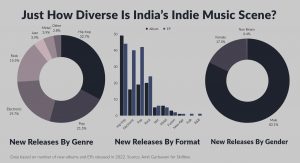We break down the Indian independent music album and EP releases by genre, gender and geography
Treating it like a New Year’s resolution, every January I resolve to document all the Indian independent music albums and EPs released over the next 12 months. And just like with most New Year resolutions, some years I succeed, some years I don’t. (Tip: Don’t get too ambitious with your resolutions. In 2021, I tried to categorise releases by month, and got so overwhelmed that I couldn’t keep up.) In 2022, however, I managed to track them on a weekly and sometimes daily basis.
The practice serves multiple purposes. It helps me stay up to date about what’s happening in the scene and is a sort of to-do list. It also serves as a means through which the music industry as a whole can get a snapshot of and then dive deep into our ever-evolving indie music segment. Last but not least, it’s a means to analyse trends in the industry, which I will elaborate on in this column.
At the time of publication, as per my tally, 119 albums and 166 EPs were put out in 2022. I have my own classification of what qualifies as an album and an EP, which on some rare occasions does not match the act’s own. I categorise a release as an album only if it has seven or more tracks and runs over 30 minutes. To me, an EP needs to have at least three songs. This might be somewhat controversial but even if you disagree with it, we can agree that at least 285 Indian indie collections with more than two songs hit streaming services last year.
That’s over two and a half times the number of Bollywood films released during the same time period, which totalled to 106, not counting films in other languages dubbed in Hindi. It was a good year for Indian indie. In my sheet, I made a separate column for artists who might not be considered indie anymore because they’re now signed to major labels (like King and Prateek Kuhad) or their albums or EP were released by a large music company (rappers signed to Universal imprint Def Jam and Kalamkaar, which has a partnership with Sony). Here again, my classification might be debatable. I’ve included Divine in the independent albums list because Mass Appeal’s deal with Universal Music has ended and they’re now distributing through The Orchard.
Given that most Indian indie artists bootstrap their recordings, it’s no surprise that there were more EPs than albums. I further divided the releases by gender, genre and geographic location, and in this piece compare the statistics to those of the live music scene. The results, as they say, were interesting.

Genre-wise break-up
Hip-hop was by far the genre with the most releases with 93, split between 49 albums and 44 EPs. Pop, with 61 (19 albums, 42 EPs), and electronic music with 56 (16 albums, 40 EPs) were almost neck and neck but at a distant second place. Rock with 44 (20 albums, 24 EPs) rounded up the top four. The rest were made up of jazz and metal (11 each), fusion (5), new age (2), folk (1) and R&B (1).
Hip-hop is clearly a genre where quantity counts and the past year saw some artists issue multiple efforts. How does this compare with the live music scene? Electronic music was the biggest genre, based on ticket sales on Skillboxes.com, followed by hip-hop and Indian indie. In this case, we’re taking the term ‘indie’ to refer to live pop and rock acts, and it seems to be a genre where more artists are putting out new music than playing that music live. Which again is unsurprising given that most venues in our country favour booking dance-friendly DJs and producers over bands and solo singers.
Gender-wise break-up
We’ve often remarked about how lopsided Indian independent music festival line-ups are in favour of men. Sadly, the same is true for album and EP releases. A whopping 82% of all the releases in 2022 – 234 out of 285 – were by male artists. Solo artists who identify as women accounted for a mere 11%, mixed gender acts 7% and non-binary performers 0.4%. Notably, those who identify as women put out three times as many EPs (23) as compared to albums (7!).
Perhaps these statistics would look a bit different if singles were included but based on the data at hand, it would seem that some long-running all-genre festivals are actually doing a relatively decent job in spotlighting women in their line-ups. Compared to the 18% releases by solo female artists, mixed gender acts and non-binary performers, the corresponding stat for the roster of the November 2022 edition of the Bacardi NH7 Weekender was 35%. At the Ziro Festival of Music, the proportion was 26%. Notably, a number of the women programmed for Weekender have released a number of singles but have yet to share a full-length effort.
Geography-wise break-up
Here’s where the recorded music and live music sectors most closely match each other. The cities that generated the most albums and EPs in 2022 were Mumbai (86), New Delhi (69) and Bengaluru (33) in that order. Bengaluru was the top city for live concerts last year followed by Mumbai and New Delhi.
It could be that Mumbai ranks higher for recordings because it’s regarded as the unofficial capital of hip-hop (I’m from Mumbai so I might be biassed). This, however, is only partially true because more hip-hop artists from New Delhi released albums (16) than those from Mumbai (14). But more rappers from the entertainment and financial capital (16) dropped EPs than those from the political capital (10).
Rounding out the top five for album and EP releases was Pune (12), which was No.5 when it came to gigs, and Kolkata (10), No.7 on the live music list. What’s particularly heartening though is that it’s not just other metros such as Chennai (5), Hyderabad (5), Jaipur (5) that are home to indie acts. No less than 37 cities across the country accounted for at least one release. In fact, Guwahati (3) and Srinagar (3) had almost as many as Ahmedabad (4). Today, it’s not unimaginable that India’s next indie superstar could emerge out of Dimapur or Landour.




